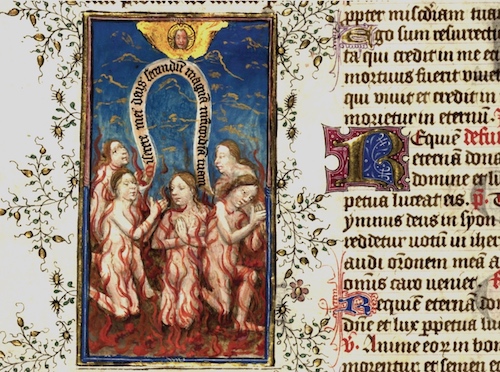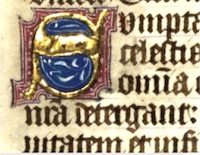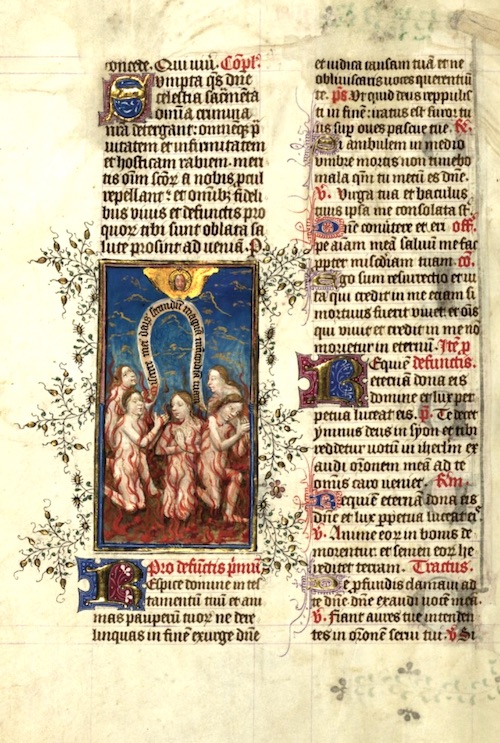Souls in Purgatory, Missal of Eberhard von Greiffenklau (c. 1425–1450)
- JENNIFER HEALY
Out of the depths I cry to you, O Lord! (Ps 130:1)

From the depths of suffering, from the depths of despondency, our souls cry out for the mercy and love of God. Here in this image, from the depths of purgatory, the Holy Souls echo the same words in a visual language.
More than just an illustration, just as the liturgical prayers in the missal are more than mere words, this miniature painting evokes the reality of the souls in purgatory, the invisible reality of the Church suffering.
This is one painting among many in this treasured Dutch manuscript from the late medieval period. The missal was made c. 1425–1450, just before the printing press turned bookmaking from an art into an industry of mass production and carefully copied and decorated manuscripts like this one became obsolete.
 The elaborate artistry throughout the book points to its sacred purpose: the celebration of the Mass. It contains all the prayers needed for the liturgical year beginning with the First Sunday of Advent. It also contains the Ordinary of the Mass, the Proper of Saints, Votive Masses, and Mass for the Dead, where this miniature appears. A calendar at the beginning of the book, with feast days marked out, indicates that it was originally made for a Carthusian monk. A coat of arms on one page links the ownership to a member of the noble family of Greiffenklau, whose wealth allowed for page after page to be illuminated with miniature works of art: depictions of the saints for their feast days; scenes of the miracles of Jesus; and decorative, gilded flowers and letters.
The elaborate artistry throughout the book points to its sacred purpose: the celebration of the Mass. It contains all the prayers needed for the liturgical year beginning with the First Sunday of Advent. It also contains the Ordinary of the Mass, the Proper of Saints, Votive Masses, and Mass for the Dead, where this miniature appears. A calendar at the beginning of the book, with feast days marked out, indicates that it was originally made for a Carthusian monk. A coat of arms on one page links the ownership to a member of the noble family of Greiffenklau, whose wealth allowed for page after page to be illuminated with miniature works of art: depictions of the saints for their feast days; scenes of the miracles of Jesus; and decorative, gilded flowers and letters.
The illuminator, unknown by name, has tucked this tiny depiction of the souls in purgatory into the space of eighteen lines of one column on the page with the prayers for the Mass for the Dead. The image serves as a reminder that, mysteriously, in the Mass we are united to the whole Church, and through our prayers the Holy Souls can reach heaven.
Chastised but not destroyed
The souls are burning but not consumed by the fire. No charred flesh disfigures their forms; only the imperfections of the souls are burned away through suffering, as they are tested by fire (1 Pt 1:7). Already in the realm of God, whose haloed head appears in the center of the golden cloud above, already somehow within the embrace of his eternal love, and certainly saved by him, the souls kneel and genuflect — or perhaps begin to rise — in adoration. Thin, golden clouds thread the sky, as if indicating that God's boundless mercy cannot be contained and fills all things.
Engulfed in flames that are painted with lively strokes of red, magenta, and orange pigment, the souls suffer the fire curling up their legs, torsos, and arms, wrapping around their wrists, and catching their throats as smoke and steam rise into the blue space above, evoking the sizzling sound of scorching heat. It is a vivid portrayal of the pain they experience.
You can't take it with you
The Holy Souls are depicted as bare bodies, on their knees in the lower part of the picture, on what appears to be muddy ground, or the miry clay (Ps 40:3). Stripped of clothes, jewelry, accessories, make-up, and all possessions; without sign of class, wealth, education, or distinction of any kind, they prepare to see God face to face, just as they are. They are suffering loss and saved as through fire (cf. 1 Cor 3:15).
Five souls are seen, not a multitude. Yet crammed as they are in the narrow space of the column, we sense that purgatory is full. As is the case with so many souls in purgatory, we do not know who they are or which creaturely attachments they need to be freed from. We are simply reminded of their suffering and of their need for our prayers. In the context of the Mass, we can be especially confident of the efficacy of our prayers, joined as we are in the Mystical Body of Christ.

Mercy
These poor souls are not shrieking in anguish, nor writhing in agony, nor desperately attempting to escape. Rather, they appear to bear this torment with humble resignation. The artist has successfully conveyed in their expressions, with their downturned gazes, a placid pondering and an apparent acceptance of where they are and what they suffer. He shows their hands in gestures of humility, adoration, and supplication. The figure on the far left looks up. With hunched shoulders and hands in prayer, he casts a humble yet hopeful gaze at our Lord, reigning above all. A scroll, looping elegantly upward, spells out the cry from the heart, Miserere mei Deus secundum magnam misericordiam tuam: Have mercy on me, O God, in accord with your merciful love (Ps 51:3). The great mercy of God is their hope, is our hope, and is why we pray for the souls in purgatory who will one day rejoice in paradise.
There is no strictly practical purpose for the illuminator to include this miniature painting in the missal; obviously the Carthusian monk who used it could read Latin and would have been able simply to pray using the written words. Yet we find that this image, with its lovely golden frame surrounded by a delicate, flowering vine, enlivens the page and touches our imagination. It sharpens our senses and allows our mind to focus on the reality of the Church suffering. It urges us to pray fervently for their relief.
In this month of November, the Church especially remembers the faithful departed, and asks for prayers, almsgiving, and sacrifices for the souls in purgatory. What a marvelous work the artist has made, so that now centuries later — and by means of modern printing technology — we can be reminded of a timeless truth and be encouraged to perform a spiritual work of mercy. The artwork, even reprinted in Magnificat, can still serve its original purpose.
 This is Meaghen Gonzalez, Editor of CERC. I hope you appreciated this piece. We curate these articles especially for believers like you.
This is Meaghen Gonzalez, Editor of CERC. I hope you appreciated this piece. We curate these articles especially for believers like you.
Please show your appreciation by making a $3 donation. CERC is entirely reader supported.

Acknowledgement
 Jennifer Healy. "Souls in Purgatory, Missal of Eberhard von Greiffenklau (c. 1425–1450)." Magnificat (November, 2019).
Jennifer Healy. "Souls in Purgatory, Missal of Eberhard von Greiffenklau (c. 1425–1450)." Magnificat (November, 2019).
Reprinted with permission of Magnificat.
Image: Souls in Purgatory, Missal of Eberhard von Greiffenklau (W. 174, folio 168v, Column miniature) (c. 1425-1450), Masters of Zwder van Culemborg, The Walters Art Museum, Baltimore, Maryland.
The Author
 Jennifer Healy is co-director of the Language & Catechetical Institute and professor of art history in Gaming, Austria. She has a particular interest in sacred art, the relationship between art and culture, and art and the New Evangelization. Her main aims in teaching are deepening students' appreciation of the rich heritage of European art, much of which they see in their semester trips, and cultivating their innate capacity to perceive beauty.
Jennifer Healy is co-director of the Language & Catechetical Institute and professor of art history in Gaming, Austria. She has a particular interest in sacred art, the relationship between art and culture, and art and the New Evangelization. Her main aims in teaching are deepening students' appreciation of the rich heritage of European art, much of which they see in their semester trips, and cultivating their innate capacity to perceive beauty.




